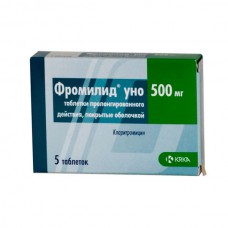Expiration date: 11/2025
Composition and form of issue:
Tablets prolonged action, film-coated. 1 tablet contains:
clarithromycin 500 mg
excipients: sodium alginate sodium calcium alginate lactose monohydrate povidone Polysorbate 80 silicon dioxide colloidal magnesium stearate hypromellose talc dye quinoline yellow (E104) titanium dioxide (E171) propylene glycol
in blistere 5 or 7 pieces in a pack a cardboard 1 (5 PCs.) or 1 or 2 (7) of the blister.
Description of dosage form:
Oval, biconvex film coated tablets in yellow, marked " U " on one side.
Pharmacokinetics:
Clarithromycin is well absorbed from the gastrointestinal tract. Food slows absorption, but it does not significantly affect the bioavailability of clarithromycin. Approximately 20% of clarithromycin is immediately metabolized to 14-hydroxyclarithromycin, which has a pronounced activity against Haemophilus influenzae. Clarithromycin easily penetrates the tissues and fluids of the body, where it reaches a concentration of almost 10 times higher than the concentration in serum. T1 / 2 after taking a dose of 250 mg is 3 to 4 h after taking a dose of 500 mg-from 5 to 7 h — From 20 to 30% clarithromycin (40% — when taking the suspension) is excreted in the urine unchanged, the rest — in the form of metabolites.
The absorption of clarithromycin from prolonged-action tablets is delayed, but is equivalent to the absorption from immediate-action tablets at equal doses. The time to reach Cmax increases. After reaching Cmax, the kinetics of both forms of clarithromycin (immediate-action tablets and prolonged-action tablets) is equivalent. The equilibrium concentration is reached by the 3rd day. Bioavailability of tablets with prolonged action is lower by 30%, when taking on an empty stomach, so patients should take a prolonged form of clarithromycin during meals. The drug is long-acting forms not recommended for patients with severe renal impairment Cl creatinine of <0. 5 ml/s. These patients can be assigned to a tablet of clarithromycin immediate-release.
Description of the pharmacological action:
Clarithromycin is a semi-synthetic antibiotic from the macrolide group. It inhibits protein synthesis in microbial cells, mainly has bacteriostatic and bactericidal action.
Clarithromycin-sensitive microorganisms: Mycoplasma pneumoniae, Legionella pneumophila, Chlamydia trachomatis and C. pneumoniae, Ureaplasma urealyticum gram-positive microorganisms (streptococci and staphylococci, Listeria monocytogenes, Corynebacterium spp.) gram-negative microorganisms (Haemophilus influenzae and N. ducreyi, Moraxella catarrhalis, Bordetella pertussis, Neisseria gonorrhoeae and N. meningitidis, Borrelia burgdorferi, Pasteurella multocida, Campylobacter spp. and Helicobacter pylori) some anaerobes (Eubacterium spp., Peptococcus spp., Propionibacterium spp., Clostridium perfringens and Bacteroides melaninogenicus) Toxoplasma gondii and all mycobacteria except M. tuberculosis.
Indications:
- upper respiratory tract infections (tonsillopharyngitis, acute sinusitis)
- otitis media
- infections of the lower respiratory tract
- skin and soft tissue infections
- infections caused by mycobacteria (M. avium complex, M. kansasii, M. marinum, M. leprae), as well as other infectious and inflammatory diseases caused by microorganisms sensitive to the drug.
Contraindications:
- hypersensitivity to clarithromycin or other antibiotics from the macrolide group
- severe hepatic insufficiency, hepatitis (history), porphyria
- The first trimester of pregnancy
- joint reception of terfenadine, cisapride, pimozide or astemizole.
Application for pregnancy and breastfeeding:
The use of the drug during pregnancy and lactation is possible only when the intended benefit to the mother exceeds the potential risk to the fetus.
Clarithromycin is excreted in breast milk, so if necessary, the appointment of the drug during lactation should stop breastfeeding.
Side effect:
Side effects include nausea, vomiting, diarrhea, and abdominal pain. In the case of severe and persistent diarrhea, pseudomembranous colitis, which may occur in some cases, the drug should be discontinued.
Also may be noted stomatitis, glossitis, headache, hypersensitivity reactions (urticaria, anaphylaxis, rarely — Stevens-Johnson syndrome), transient changes in taste sensations, CNS disorders in individual patients (dizziness, confusion, fear, insomnia, nightmares). In most patients, side effects are characterized by low intensity.
Very rarely there is an increase in the activity of liver enzymes and cholestatic jaundice.
In the treatment of clarithromycin, as with other macrolides, very rarely observed elongation of THE Qt interval, ventricular arrhythmia, including ventricular paroxysmal tachycardia and flutter or ventricular fibrillation.
In case of side effects, consult your doctor.
Drug interaction:
Clarithromycin is metabolized in the liver, where it can inhibit the action of cytochrome P450 enzymes. With simultaneous treatment with clarithromycin and other drugs metabolized through this system, the concentration of the latter may increase and cause side effects. Therefore, terfenadine, cisapride, pimozide or astemizole should not be prescribed during treatment with clarithromycin due to the threat of life-threatening arrhythmias.
It should be periodically monitored in patients receiving clarithromycin simultaneously with warfarin or other oral anticoagulants.
Simultaneous administration of clarithromycin and zidovudine reduces the absorption of zidovudine.
Coadministration of ritonavir and clarithromycin leads to a significant increase in the level of clarithromycin in serum and a significant reduction in the level of its metabolite — 14-hydroxyclarithromycin in the serum.
Method of application and doses:
Inside, while eating, swallowing whole, without breaking, squeezed small amount of liquid.
Adults and children over 12 years — 1 table. (500 mg) Fromilid UNO every 24 hours for the treatment of severe infections daily dose increased to 2 tables. (500 mg) every 24 hours.
The course of treatment — usually within 7-14 days.
Overdose:
Symptoms: probably the development of symptoms from the gastrointestinal tract (nausea, vomiting, diarrhea) headache, confusion.
Treatment: immediate gastric lavage and symptomatic treatment. Hemodialysis and peritoneal dialysis does not lead to a significant change in the level of clarithromycin in serum.
Special instruction:
In the presence of chronic liver disease, it is necessary to conduct regular monitoring of blood serum enzymes.
With caution, prescribed against drugs metabolized by the liver (it is recommended to measure their concentration in the blood).
In case of co-administration with warfarin or other indirect anticoagulants it is necessary to control the PV.
Attention should be paid to the possibility of cross-resistance between clarithromycin and other antibiotics from the macrolide group, as well as lincomycin and clindamycin.
In the case of severe, persistent diarrhea, which may indicate pseudomembranous colitis, discontinue use of the drug and consult a doctor.
Influence on the ability to drive and operate machinery. The drug does not affect the speed of psychomotor reactions of the patient when driving or working with machinery.




